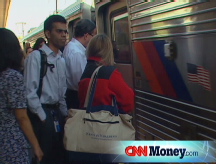Oklahoma's painful car culture
Residents used to 70-mile commutes turn to carpooling, public transport as gas hovers at $4 a gallon. Survey ranks 2 Oklahoma cities as vulnerable.
NEW YORK (CNNMoney.com) -- For many people in Oklahoma, life is built around the car.
With several refineries in the region, years of cheap fuel have made it possible for many people to live far from their jobs.
Now the situation is unraveling.
Cindy LaBeff, 46, drives 70 miles a day from the small town of McLoud to her job at a data processing center in Oklahoma City.
Until a few months ago, she spent $40 on gas for her work week. These days it's $60 a work week - and $80 if she wants to go to church on the weekend.
She decided she can't afford the higher prices. With no public transportation in her area, she went online to form a carpool.
LaBeff has been ridesharing for a week now, and she hopes to add two new members to her car. "That way, it's just a dollar a gallon," she said.
LaBeff's family and friends in her 4,000-person town also have long commutes and high gas bills. She thinks something should be done.
"If our governor or mayor would help set up carpooling, if they would push it better, then people would think about it," she said. "But there has been nothing."
Due to its sheer size, public transportation is a tough prospect in Oklahoma City.
City Manager Jim Couch says that at 627 square miles, Oklahoma City has the third greatest land mass of all U.S. cities.
It also ranked last among 50 U.S. cities in a recent study on areas best able to cope with high oil prices.
The study, published by the economic development group Common Current, starts from the premise that cities with strong public transit systems will likely remain competitive in the face of soaring gas prices.
Best able to survive and thrive are the highly populated cities in which people can get by without cars: San Francisco, New York and Chicago ranked 1, 2 and 3, respectively.
Cities without public transportation infrastructure can be vulnerable, said Warren Karlenzig, Common Current's president.
In addition to public transportation, the survey put weight on factors like telecommuting and how many people ride a bike or walked to work. Lesser factors included urban sprawl, the use of heating oil and the carpool rate.
Karlenzig said that while nearly 55% of New Yorkers take public transit, the rate in Oklahoma is closer to 2%.
Oklahoma City's Couch said improving public transportation is a priority.
The city is several years into a study of a rail transit system in the hopes of attracting federal money for it.
Any results are years away, but "we're making a lot of progress," Couch said.
He also said the city is looking into providing bus service to a major manufacturing distribution center on the west side of town whose employees are finding it harder to afford the drive to work.
High gas prices are also causing an increase in demand for public transport in neighboring Tulsa, Okla. Tulsa ranked second to last in the Common Cause study.
Tulsa transit manager Bill Cartwright said urban professionals, who rarely rode the bus before, are now among his customers.
"You've got people coming out of the woodwork, screaming for more bus service. We get calls and emails daily," said Cartwright.
Common Current's Karlenzig thinks public transportation is a benefit more and more people will come to appreciate.
"It's a lifeline for all citizens now, not just lower income citizens," he said. ![]()






